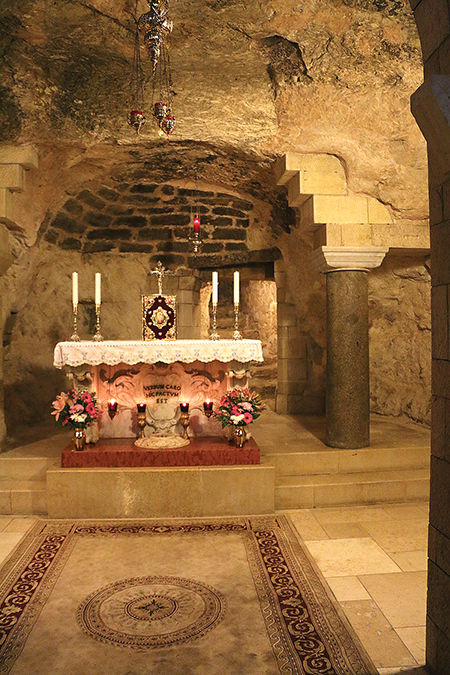It’s easy to slip when walking the Via Dolorosa in Old City Jerusalem, especially if it’s raining. The stones are so worn down, so smooth. So many pilgrims over the centuries have followed in the Lord’s footsteps, contemplating his Passion.
The stations on the Via are not equal distance one from the next, as they are displayed in our churches. The fourth station, when Jesus met his mother, is right next to where he fell the first time, the third station.
This struck me when I visited the Holy Land for the first time earlier this year. I recalled that part of the film “The Passion of the Christ,” where the Lord, falling with the cross, consoles Mary. “See, mother. I make all things new.”
For some reason, the varying distance between the stations helped me believe it was real. I can be such a skeptic. But she stood on this ground watching her son, another face in the crowd.
This is the place where he was condemned — “Crucify him!” — where he carried the cross, where he would have died. “Into your hands I commend my spirit.”
On the final ascent to Calvary, before the 10-14 stations, pilgrims walk between gift shops. Vendors wait anxiously to sell trinkets, wooden crosses or even crowns of thorns. It’s somewhat disconcerting, but some do take selfies at the different stations.
Children on bikes zoom by Filipino pilgrims carrying a large wooden cross. Orthodox Jews make their way to the Western Wall. Israeli soldiers stroll past chatting women in hijabs. The women may be on their way to the Dome of the Rock.
All three faiths — Christian, Jewish and Muslim — now coexist peacefully within the walls of the old City. But more than 1,000 years ago, the Egyptian caliph ordered the destruction of the church.
In the rebuilt Church of the Holy Sepulchre, where most Christians agree the Lord was crucified, pilgrims climb steep stairs to kneel where the Blessed Mother kneeled as she watched her son take his last breath.
“Behold your mother,” he said to his Beloved Disciple — that happened right here. This is Golgotha.
Franciscans and Eastern Orthodox churches share the space, adhering strictly to agreements that have remained mostly unchanged for centuries. An Orthodox priest scraped candle wax off the floor a few steps away from where the Lord died on the cross.
Pilgrims, many who’ve traveled thousands of miles to pray here, are shuffled off to make room for a Franciscan-celebrated Mass.
Pope Francis and Ecumenical Patriarch Bartholomew I of Constantinople prostrated themselves together to kiss a slab of stone on which the Lord’s body was prepared for burial. Pilgrims wait an hour or more to enter into the tomb said to be where they laid his body to rest for three days.
In the old city, pilgrims will find David’s tomb not far from the Upper Room. Both are a stone’s throw from the Church of the Dormition, where the Blessed Mother is said to have fallen asleep before being assumed into heaven.
Outside the walls, at the base of the Mount of Olives, the Church of All Nations is built upon the rock where the Lord is said to have prayed before he was taken on Holy Thursday.
When the Word was made flesh, he walked this land. The churches make it harder to imagine what it must have been like, but they have also protected the locations from secular buildings.
Not far from the Old City is Bethlehem, where the Holy Family, in town for a special census, finally found lodging on that holy night when Christ was born.
The Church of the Nativity, one of the oldest Christian churches, is built on this ground.
In Nazareth, the enormous Basilica of the Annunciation rests above the remains of what is believed to be Mary’s childhood home. Catholic tradition maintains that this is where the angel Gabriel declared onto Mary, where Jesus was conceived by the Holy Spirit in his mother’s womb.
A smaller church nearby is built on the grounds where the Holy Family dwelt. This where the child Jesus grew up.
A bit farther north is Cana, Jesus and his friends and his first miracle. A bit east, Galilee. This is where he might have preached the Sermon on the Mount, so key to our Catholic teaching.
At least there isn’t a church built on the Sea of Galilee! This is where the Lord walked on water, where he taught Saint Peter the gift of faith, another place where he revealed his divinity.
I stopped at a Lebanese restaurant for what they call a Saint Peter’s fish, possibly a distant relative of a fish the Lord ate two thousand years ago. It was delicious.
On these shores pilgrims visit the place where Jesus fed the multitudes. Capernaum, where you can visit the ruins believed to be Peter’s house, where early Christians met.
On my way to the Church of the Primacy of Peter, I hear a familiar voice. It’s Father Thomas Anslow, Vicar of Canonical Services for the Archdiocese of Los Angeles. What are the chances?
The small Franciscan church there, where at the end of the Gospel of John, Peter is said to have jumped ashore, recognizing the resurrected Lord. Peter had denied the Lord three times, so the Lord reinstates him.
“Simon, son of John, do you love me more than these?”
“Yes Lord, you know that I love you.”
Three times the Lord asks, and three times Peter answers yes.
“Feed my sheep.”
There are also many other places, but if each were to be described individually, I don’t think the whole world would contain the newspapers that would be printed.
J.D. Long-García traveled to the Holy Land with Israel’s Ministry of Tourism. To learn more or to arrange a pilgrimage, vist www.goisrael.com.

